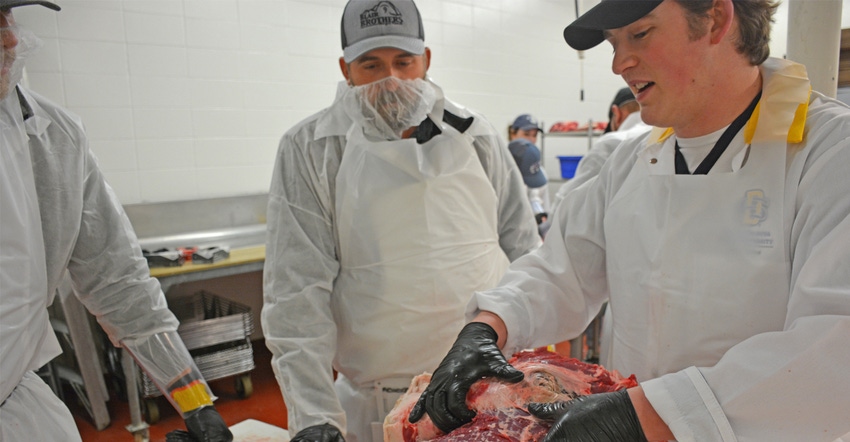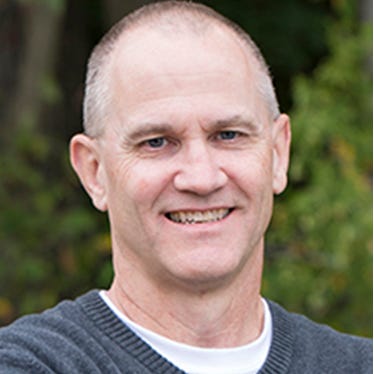
Peyton Bahe and his wife, Courtney, have experience raising cattle. She grew up in the industry on her family’s ranch near Wall, S.D. Though Peyton’s parents were both in health care, he gained cattle experience through friends and neighbors, and has worked as a hired man over the years.
The couple now has their own black Angus cow-calf operation, and Peyton works for Blair Brothers Angus near Vale, S.D.
Even with that cattle experience, it never hurts to hone ranching skills. The Bahes recently took part in the Beef 20/20 workshop hosted by South Dakota State University Extension. Beef 20/20 is a hands-on workshop for cattle producers, beef purveyors and allied industry representatives to address the preharvest management factors that influence beef carcass value.
Christina Bakker, SDSU assistant professor and Extension meat science specialist, says, “We really want to connect how what happens to the animal really does impact the final eating experience for the consumers. So we talked about different things, such as how genetics and animal disposition can impact the final carcass, as well as looking at how the animal finishes right at the time of marketing, right before it goes to the packing plant.”
Beef 20/20 participants also tried their hand at evaluating live cattle, as well as quality and yield grading beef carcasses.
Find extra value
Peyton’s biggest takeaway from the three-day program is the value being left on the table with their animals.
“I guess the biggest takeaway is finding that extra value in your calves, whether you take them to a sale barn or you’re retaining ownership and having them processed out of packer. Even seeing the value of if we make changes in our genetics, the carcass traits that provide a better animal and a higher-quality-yielding animal. You are going to see more money at the end when you put the effort into the whole process.”
The Bahes are also involved in the two-year BeefSD, an intensive educational program designed to take participants to the next level in beef production, “which teaches us from pretty much before the calf is born to when it’s hanging on the rail, and this [Beef 20/20] really expands on what we want to do and figure out how can you get the most value out of whatever animal you’re selling,” Peyton says.
Much like the “hoof-to-rail” approach of BeefSD, the three-day Beef 20/20 program took the 20-some participants through a mix of discussions covering topics including on-farm management that impacts carcass quality, import-export balance for beef products, marketing slaughter cattle and factors that affect eating quality.
A good portion of the second day of Beef 20/20 was spent in the SDSU Meat Lab, where participants teamed up to fabricate forequarters and hindquarters of beef animals that had been slaughtered on Dec. 8. After Adam Rhody, meat lab manager, demonstrated how to break down each quarter and the specific cuts found in each quarter, the teams then went to work on their own quarters.
Peyton had processed deer and elk from hunts, and had assisted friends is processing beef animals, “but we just grind most of it,” which was different than what the teams learned at Beef 20/20.
“The carcass is a lot bigger [steer vs. deer],” Peyton says, “and you have to get the different muscle groups out so that they can break it down into the different cuts.
In addition to merely breaking down the quarters, Bakker says participants “cut it down into those retail cuts, and then in the end, they put it back into what the value of all of those cuts from that carcass were, and whether or not they made any money in our fake auction where they ‘purchased’ the carcasses they are fabricating.”
Lessons back to the ranch
Hearing the Beef 20/20 speakers talk about how animal disposition impacts the end beef product, Peyton says he and Courtney, as well as the people at Blair Brothers, put animal care front and center.
“We’re big on the low-stress handling,” Peyton says. “We feel less is more, so we have less people usually when we work our cattle.”
He says they follow the techniques and practices of Curt Pate and Tom Noffsinger, two experts in proper livestock handling. “Anytime they have a clinic, we tend to go,” Peyton says, adding that whenever there’s a new employee, they try to teach that person the same low-stress handling.
Experiencing programs such as Beef 20/20 and BeefSD has taught the Bahes the value of knowing your beef animals’ value. In addition to finding the aforementioned extra value in your calves, Peyton says ranchers “need to find where your herd stands. You need to go beyond the ranch or the sale barn to see how your cattle stack up to everyone else’s cattle, as well as what the consumer wants. You can sit there and just keep breeding the same types of animals, but how do you know how good of a job you are doing if you don’t test?”
Receiving data from the packer can give ranchers information “on what they need to change or if you have any shortcomings,” Peyton says. Some of those shortcomings may be in knowing when to say goodbye to a cow that is no longer performing. “If you have a single animal that year after year does not perform, then it locks in your mind that you need to get rid of that animal.”
Though that decision can be tough, especially with cows that have been in the herd a long time, Peyton says it’s a decision that needs to be made for the betterment of the entire herd.
About the Author(s)
You May Also Like






